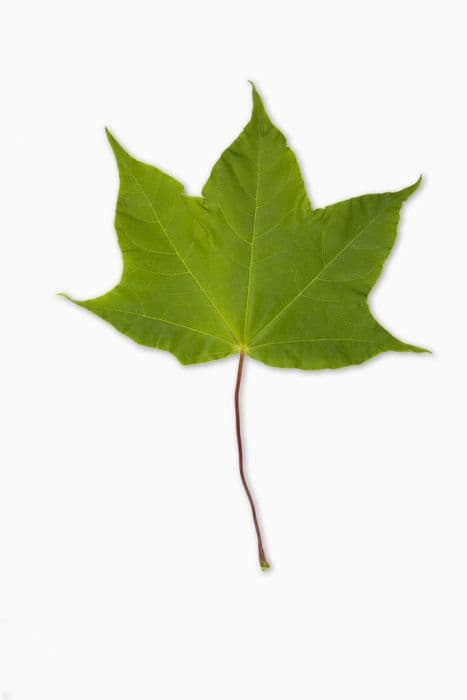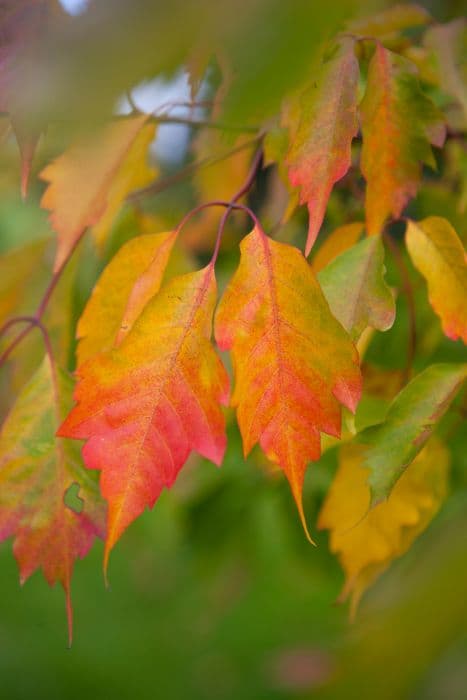Red Maple Acer rubrum 'Brandywine'
ABOUT
The Brandywine Red Maple is a visually striking deciduous tree known for its colorful and versatile aesthetic appeal across seasons. In the spring, the tree displays modest red flowers that can add a subtle touch of color to the landscape. The foliage of the Brandywine Red Maple is especially notable; the leaves emerge with a bright red tint in the spring, transforming into a rich green as they fully mature through the growing season. These leaves are typically shaped with three to five lobes with serrated edges, providing a classic maple leaf appearance that is often quintessential in representing the fall season. As autumn approaches, the Brandywine Red Maple truly stands out with its vibrant fall colors. The leaves undergo a dramatic transition to display a spectrum of shades from purplish-red to a brilliant red, making the tree a popular choice for those looking to enhance their landscape with spectacular fall foliage. The leaves eventually fall, leaving behind a bare tree with an attractive silhouette in the winter landscape. The bark of the Brandywine Red Maple adds to its year-round interest. When the tree is young, the bark tends to be smooth and gray. As it matures, the bark develops deeper furrows and ridges, providing textural contrast to the smooth surfaces of younger trees and an appealing characteristic during the leafless months. In terms of its reproductive attributes, the Brandywine Red Maple bears flowers that develop into a recognizable fruit called samaras, commonly referred to as "helicopter seeds" due to their unique shape that allows them to spin as they fall to the ground. These samaras can be seen in late spring to early summer and are typically red or reddish-brown in color. Overall, the Brandywine Red Maple's visual charm throughout the seasons makes it a cherished selection for both residential and public landscapes, providing year-long interest and beauty.
About this plant
 Names
NamesFamily
Sapindaceae
Synonyms
Brandywine Red Maple, Brandywine Maple
Common names
Acer rubrum 'Brandywine'.
 Toxicity
ToxicityTo humans
The Red Maple tree, including the 'Brandywine' cultivar, is not generally considered toxic to humans. However, as with many plants, individual sensitivity to plant parts can vary, but typical ingestion of leaves or seeds in small quantities is not known to cause significant harm or toxic symptoms in humans.
To pets
The Red Maple tree, particularly the 'Brandywine' variety, can be toxic to pets, especially horses. Ingesting leaves, especially wilted or dried leaves that may contain higher concentrations of toxins, can cause a condition called Red Maple leaf poisoning or equine hemolytic anemia. Symptoms in horses can include lethargy, jaundice, dark brown urine, increased heart and respiratory rates, and potentially death if not treated promptly. While the Red Maple is most notably toxic to horses, other pets such as dogs and cats are less commonly affected. However, it is wise to prevent pets from ingesting plant material from this tree.
 Characteristics
CharacteristicsLife cycle
Perennials
Foliage type
Deciduous
Color of leaves
Green
Flower color
Red
Height
25 feet (7.62 meters)
Spread
12 feet (3.65 meters)
Plant type
Tree
Hardiness zones
3-9
Native area
North America
Benefits
 General Benefits
General Benefits- Ornamental Value: Provides vibrant fall color with shades ranging from yellow to deep purple and red.
- Wildlife Habitat: Supports local wildlife by providing shelter and food for birds and small mammals.
- Erosion Control: Its root system helps stabilize soil and prevent erosion on slopes.
- Shade: Creates a cooling effect in landscapes and reduces the need for air conditioning in nearby spaces.
- Carbon Sequestration: Contributes to carbon capture, helping to mitigate climate change.
- Year-Round Interest: Offers multi-season visual interest, with flowers in spring, leafy green canopy in summer, fall color, and a striking silhouette in winter.
- Adaptability: Tolerant of a variety of soil conditions, making it suitable for many landscapes.
- Low Maintenance: Requires minimal care once established, reducing the need for watering, fertilizing, and pruning.
 Medical Properties
Medical PropertiesThis plant is not used for medical purposes.
 Air-purifying Qualities
Air-purifying QualitiesThis plant is not specifically known for air purifying qualities.
 Other Uses
Other Uses- Acer rubrum 'Brandywine', commonly known as Red Maple, can be tapped for syrup, similar to sugar maples, though the sugar content in the sap is lower.
- The wood of Red Maple is sometimes used in the production of musical instruments, offering a source for high-quality wood in the manufacturing of violins and guitars.
- Red Maple's wood is also utilized for the creation of woodturning projects, including bowls and spindle work, favored for its fine grain and attractive coloring.
- The tree's dense canopy can serve as a natural privacy screen when planted in a row, effectively creating a green fence without the need for construction.
- Due to its vivid fall color, Red Maple branches may be harvested and used for decorative purposes in seasonal floral arrangements and displays.
- Leaves of the Red Maple are sometimes used in craft applications, such as making leaf prints or as natural stencils for art projects due to their distinct shape.
- In landscape design, the Red Maple is frequently used to create a focal point in large gardens or public parks, given its striking autumn coloration.
- The tree provides nesting sites and habitat for various species of birds, making it valuable for bird-watchers and for supporting local ecosystems.
- The tannin extracted from the bark of Red Maple has historical use in tanning leather, although it is not commonly used for this purpose today.
- Red Maple's fallen leaves can be collected and repurposed as a natural mulch or composted to enrich garden soil as they decompose.
Interesting Facts
 Feng Shui
Feng ShuiRed Maple is not used in Feng Shui practice.
 Zodiac Sign Compitability
Zodiac Sign CompitabilityRed Maple is not used in astrology practice.
 Plant Symbolism
Plant Symbolism- Strength: The robust growth and hardwood of Acer rubrum, commonly known as the red maple, symbolize physical and inner strength.
- Wisdom: As a long-lived tree, the red maple is often associated with wisdom and knowledge accumulated over time.
- Beauty: The vibrant red color of its leaves, especially in autumn, represents beauty and the aesthetic pleasures of nature.
- Balance: The symmetrical shape of the red maple leaf symbolizes balance and the harmony of nature.
 Water
WaterBrandywine Maple should be watered deeply once a week during dry periods, especially in the first few years after planting to establish a strong root system. An established Brandywine Maple generally requires around 1 to 1.5 inches of water per week, either from rainfall or irrigation. For young trees, use approximately 15 to 20 gallons of water weekly, ensuring it reaches the deeper root zone. During hot or windy weather, increase watering to prevent stress. Always allow the soil to dry slightly between watering sessions to prevent waterlogging.
 Light
LightBrandywine Maple thrives best in full sun to partial shade conditions. Ideally, it should receive at least 4 to 6 hours of direct sunlight per day. While this maple can tolerate some shade, the best growth and fall color tend to occur in a location where it's exposed to ample sunlight throughout the day.
 Temperature
TemperatureThe Brandywine Maple is hardy in USDA Zones 4 through 9 and can survive temperatures as low as -30°F and as high as 100°F. However, the ideal temperature range for this plant is between 60°F and 80°F. It is suited for a broad range of climates and can withstand typical temperature fluctuations within its hardiness zones.
 Pruning
PruningPruning Brandywine Maple is important for removing damaged or diseased limbs and encouraging a strong tree structure. It should be pruned in late winter or early spring before new growth starts, as this is when the tree is dormant. Aim to prune Brandywine Maple every 3 to 5 years to maintain its shape and health, removing any crossing branches or those that grow inward towards the center of the tree.
 Cleaning
CleaningAs needed
 Soil
SoilThe Brandywine Red Maple requires a well-draining soil mix with a slightly acidic to neutral pH, typically between 5.5 and 7.0. A mixture of loamy soil, peat moss, and sand or perlite can provide the necessary drainage and aeration.
 Repotting
RepottingThe Brandywine Red Maple typically does not require frequent repotting as it is a large tree, but young trees should be repotted every 2-3 years to encourage growth, using a larger pot each time to accommodate root development.
 Humidity & Misting
Humidity & MistingBrandywine Red Maple is adaptable to outdoor humidity levels and does not require specific humidity conditions when planted outdoors . It thrives in natural outside air.
 Suitable locations
Suitable locationsIndoor
Not suitable for indoor growth; needs outdoor space to thrive.
Outdoor
Plant in full sun to partial shade, in moist, well-drained soil.
Hardiness zone
4-9 USDA
 Life cycle
Life cycleThe 'Brandywine' Red Maple (Acer rubrum 'Brandywine') begins its life cycle as a dormant seed, which requires a period of cold stratification to germinate. Upon sprouting in spring, the seedling will gradually establish a root system and sprout its first shoots and leaves, entering the juvenile growth phase. As it matures into an adult tree, it develops a characteristic rounded to an oval crown with deep green foliage that turns vivid red and purple in fall. Throughout its reproductive stage, the 'Brandywine' Red Maple produces small, attractive red flowers in early spring before the leaves emerge, which give way to the distinctive samaras, or "helicopter seeds," that disperse with the wind. The tree continues its reproductive cycle annually with flowering and seed production. With proper care and favorable conditions, 'Brandywine' Red Maple can live upwards of 70 to 80 years, undergoing cycles of growth, reproduction, and finally senescence before dying.
 Propogation
PropogationPropogation time
Late winter to early spring
The most popular method of propagation for the Red Maple 'Brandywine' is by seed. Seeds should be collected in the fall when they turn a light brown color. Once collected, they require a period of cold stratification to simulate winter conditions and break seed dormancy. This is generally done by mixing seeds with moist sand or peat and refrigerating them at 34-40 degrees Fahrenheit (1-4 degrees Celsius) for 1-3 months. After stratification, seeds can be sown in well-drained soil in a sunny to partially shaded location. They should be planted at a depth that is twice the diameter of the seed, usually about a quarter inch (about 6mm) deep. Watering should be consistent to keep the soil moist until germination occurs.









